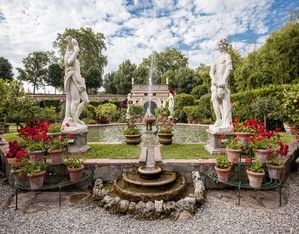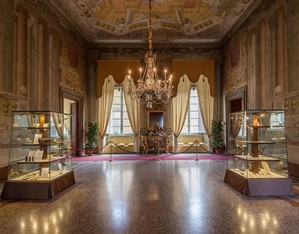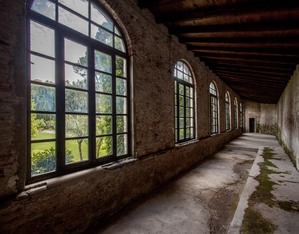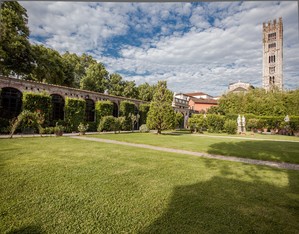 Warning
Warning
Due to the current health emergency situation visiting times and arrangements may be subject to change. It is therefore advisable to check them by contacting the Palace directly.
Take a walk down the avenue of plane trees that runs along Lucca’s 16th-century walls, near the church of San Frediano, and discover the beauty of a garden set like a gem into the fabric of the city.
At first glance, this garden appears to be a hortus conclusus, albeit one that maintains a constant relationship with both the city walls/the tree-lined promenade, and the urban backdrop. In the second half of the 17th century, the Moriconi family began work on the palazzo and garden. By the end of the century, a family of silk merchants, the Contronis, had taken over the property and enriched the complex with a splendid external staircase (there is some debate whether it was designed by Filippo Juvarra or Domenico Martinelli) as a scenic filter between the palazzo and the garden. The early 18th-century, theatrical garden is attributed to Juvarra. The central sector is arranged along a perspective centreline marked out by statues of gods and mythological heroes. At the sides of the entrance, in two niches, are statues of “Magna Mater” Cybeleand Hercules, guardian of the garden of the Hesperides. The large central octagonal basin features the Four Elements (Vulcan as the symbol of Fire, Mercury of Air, Dionysus of Earth, and Ocean of Water). A large lemon house in the background, along the walls, sports an elegant brick facade dotted with large windows that alternate with laurel hedges. Two lions (attributes of Cybele) flank the basilisk, the Controni family emblem, on the topmost balustrade. The other sector of the garden consists of large lawn areas with numerous earthenware tubs of lemon trees, some of which bear the date 1843. Tall topiary hedges of laurel and box run along the sides of the formal garden, along with two bamboo groves of 19th-century origin, added when the property was purchased by Felice Pfanner, an industrialist of German origin who in 1856 set up a brewery that produced beer here until 1929.
Highlights

Waterworks System
An octagonal masonry pool, partly modified by rockery beds, stands at the mid-point of the central avenue. The basin is surrounded by a wide border along its sides, which functions as a kind of blossoming platform. It also features an interesting waterworks system, of which the circular underground tanks remain.

Interiors
Painted in around 1720 by Pietro Paolo Scorsini, valuable frescoes in the “quadraturist” style line the walls of the hall. The central hall is flanked by a tea room, a bedroom, a dining room and a historic kitchen, all furnished with antique furniture, period furnishings and sacred objects.

The Brewery
In 1856 (and until 1929), the first brewery in the Duchy of Lucca and one of the first in Italy was set up in this garden. We may still see the iceboxes, masonry tanks and, concealed behind a high laurel hedge, the former beermaking factories.

Film Set
Director Jane Campion chose this garden for its great beauty in 1996 to film some of the exterior scenes for her movie adaptation of “Portrait of a Lady”, based on the Henry James novel. Scenes from “Il Marchese del Grillo”, starring Alberto Sordi, were also filmed here.
 Palazzo Pfanner
Contacts
Palazzo Pfanner
Contacts
 Palazzo Pfanner
Opening times and prices
Palazzo Pfanner
Opening times and prices
Opening hours
The Palace and the Garden are open from April to November (can be visited on request also at other times and periods).
Opening hours: daily 10.00 am – 18.00 pm
Pricing
Visit to the garden and the residence
Full price: € 6, 50
Reduced price: € 5, 50 (children 12-16 years old / students / adults over 65 years old)
Groups (more than 10 people): € 4,50
Visit to the residence
Full price € 4, 50
Reduced price € 4,00 (children 12-16 years old / students / adults over 65 years old)
Groups (more than 10 people): € 4,00
Visit to the garden
Full price € 4,50
Reduced price € 4,00 (children 12-16 years old / students / adults over 65 years old)
Groups (more than 10 people): € 4,00
Free admission for children under 12.
 Palazzo Pfanner
How to get there
Palazzo Pfanner
How to get there
Address
Via degli Asili, 33
55100, Lucca (LU)
Latitude: 43.845556
Longitude: 10.5007092
How to arrive by road
From Lucca
Leave the A11 motorway at the Lucca Est exit. Continue along Viale Europa, then along the Lazzaro Papi and Carlo del Prete ring roads. Enter the city through Porta Santa Maria. Continue to the right along Via della Cavallerizza. Get to Piazza San Frediano. Continue on Via Cesare Battisti. Take the first right onto Via degli Asili.
From Capannori
Take via Pesciatina. Continue along Via Pesciatina to the end of Viale Castruccio Castracani. Then turn right along the avenues of corconvallazione Guglielmo Marconi and Agostino Marti. Arrive at the Borgo Giannotti roundabout. Enter the city through Porta Santa Maria. Continue to the right along Via della Cavallerizza. Get to Piazza San Frediano. Continue on Via Cesare Battisti. Take the first right onto Via degli Asili.
How to arrive by train
Exit the train station and take via Cavour. Turn right immediately and continue along the avenues Giuseppe Giusti, Giacomo Pacini, Guglielmo Marconi and Agostino Marti. Arrive at the Borgo Giannotti roundabout. Enter the city through Porta Santa Maria. Continue to the right along Via della Cavallerizza. Get to Piazza San Frediano. Continue on Via Cesare Battisti. Take the first right onto Via degli Asili.
Additional directions
Land at Galilei Airport in Pisa. Take the A12 motorway in the direction of Genoa. Continue on the A11 towards Florence at the Pisa nord junction. Exit at the Lucca Est tollbooth. Continue along Viale Europa, then along the Lazzaro Papi and Carlo del Prete ring roads. Enter the city through Porta Santa Maria. Continue to the right along Via della Cavallerizza. Get to Piazza San Frediano. Continue on Via Cesare Battisti. Take the first right onto Via degli Asili.
 Palazzo Pfanner
Services/Accessibility
Palazzo Pfanner
Services/Accessibility
Accessibility
The garden can also be visited by people with disabilities as there are no architectural barriers. However, the residence is not accessible to the handicapped.
 Palazzo Pfanner
Private events
Palazzo Pfanner
Private events
 Palazzo Pfanner
Itineraries
Palazzo Pfanner
Itineraries
You could find the garden in these itineraries
 Favorite saving result
Favorite saving result
 Warning!
Warning!
You've have to sign up or sign in to add this element to your favorites.
